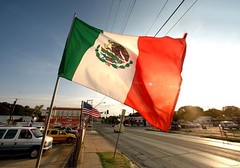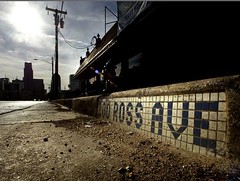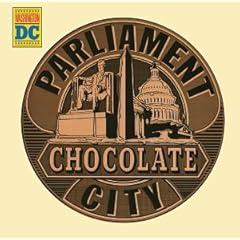The times (and places) they are a-changing

Parts of Ross Avenue have shown the influence of Hispanic residents and culture for years, including this used car lot which displays both the U.S. and Mexican flags. Guy Reynolds, Dallas Morning News.
There is a lot of discussion about the change in African-American politics and post-racial politics due to the Barack Obama candidacy.
I had a spirited e-discussion with the author of this piece, "The last gasps of black victimology?" which appeared in the Baltimore Sun. (He disagrees with me about the value of dependency theory as an explanatory tool. I disagree that Latin American dependency theory ever called for "reparations" as a solution, but rather demanded a material change in the relationship between countries in the periphery vis-a-vis the center nations, as well as the power relations within countries.)
There is a long piece in the New York Times Magazine as well, "Post-Race - Is Obama the End of Black Politics," plus an interesting piece by David Brooks (who mostly I disagree with), "Where’s the Landslide?," about the apartness of Obama making it difficult for people to "place" him and connect with him.
At the same time, I can't help but wonder about post-racialism in American politics being partly a function of demographics. The fact is that the African-American population is shrinking relative to other "minorities" such as Hispanics, and the population is so concentrated within cities that politically it may become increasingly irrelevant, see e.g., post-Katrina New Orleans as well as elections in places like NYC (post-David Dinkins) and Los Angeles (post-Tom Bradley).
This piece in the Dallas Morning News speaks to the issue somewhat, "In Dallas, Ross is avenue of development, diversity, debate," in terms of people being cautious about changing the name of Ross Avenue to Cesar Chavez Boulevard.

Guy Reynolds, Dallas Morning News.
Like controversies over changing the name of a district to Little Saigon in San Jose, or a desire to add the designation "Little Ethiopia" to a stretch of DC's 9th Street NW a few years--both efforts were unsuccessful--change is all around us, whether or not we want to admit it or respond to it.
Forty years ago these debates were over the changing of the name of streets in honor of Dr. Martin Luther King, Jr.
Today, other peoples are vying for the opportunity to name their places and seek acknowledgment of changing circumstances--and demographics.
------
For why I believe dependency theory is a powerful theory for understanding development in disinvested places in the "first world" (of course, maybe for the most part within metropolitan areas cities are the new peripheries rather than the centers) see "Enclave development won't save Anacostia."

Album cover, Parliament, 1975.
Labels: electoral politics and influence, invasion-succession theory, urban revitalization, urban sociology



0 Comments:
Post a Comment
<< Home